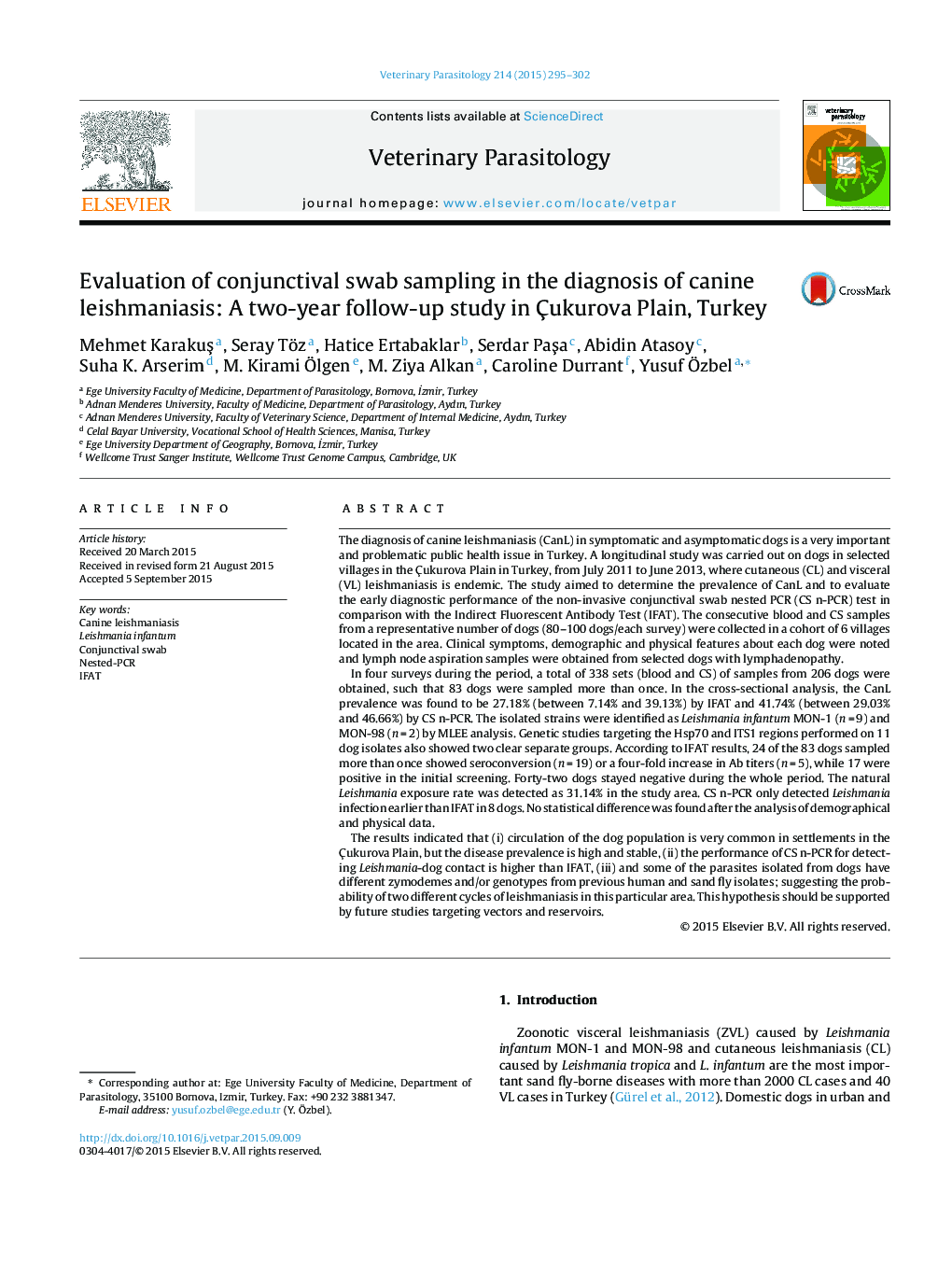| کد مقاله | کد نشریه | سال انتشار | مقاله انگلیسی | نسخه تمام متن |
|---|---|---|---|---|
| 2469913 | 1555662 | 2015 | 8 صفحه PDF | دانلود رایگان |
• The epidemiology of canine leishmaniasis was studied first time in Çukurova Plain of Turkey.
• Conjunctival swab samples can be used as a non-invasive clinical sample for the diagnosis of CanL using DNA-based tools.
• CS n-PCR is a useful tool for showing Leishmania-dog contact.
The diagnosis of canine leishmaniasis (CanL) in symptomatic and asymptomatic dogs is a very important and problematic public health issue in Turkey. A longitudinal study was carried out on dogs in selected villages in the Çukurova Plain in Turkey, from July 2011 to June 2013, where cutaneous (CL) and visceral (VL) leishmaniasis is endemic. The study aimed to determine the prevalence of CanL and to evaluate the early diagnostic performance of the non-invasive conjunctival swab nested PCR (CS n-PCR) test in comparison with the Indirect Fluorescent Antibody Test (IFAT). The consecutive blood and CS samples from a representative number of dogs (80–100 dogs/each survey) were collected in a cohort of 6 villages located in the area. Clinical symptoms, demographic and physical features about each dog were noted and lymph node aspiration samples were obtained from selected dogs with lymphadenopathy.In four surveys during the period, a total of 338 sets (blood and CS) of samples from 206 dogs were obtained, such that 83 dogs were sampled more than once. In the cross-sectional analysis, the CanL prevalence was found to be 27.18% (between 7.14% and 39.13%) by IFAT and 41.74% (between 29.03% and 46.66%) by CS n-PCR. The isolated strains were identified as Leishmania infantum MON-1 (n = 9) and MON-98 (n = 2) by MLEE analysis. Genetic studies targeting the Hsp70 and ITS1 regions performed on 11 dog isolates also showed two clear separate groups. According to IFAT results, 24 of the 83 dogs sampled more than once showed seroconversion (n = 19) or a four-fold increase in Ab titers (n = 5), while 17 were positive in the initial screening. Forty-two dogs stayed negative during the whole period. The natural Leishmania exposure rate was detected as 31.14% in the study area. CS n-PCR only detected Leishmania infection earlier than IFAT in 8 dogs. No statistical difference was found after the analysis of demographical and physical data.The results indicated that (i) circulation of the dog population is very common in settlements in the Çukurova Plain, but the disease prevalence is high and stable, (ii) the performance of CS n-PCR for detecting Leishmania-dog contact is higher than IFAT, (iii) and some of the parasites isolated from dogs have different zymodemes and/or genotypes from previous human and sand fly isolates; suggesting the probability of two different cycles of leishmaniasis in this particular area. This hypothesis should be supported by future studies targeting vectors and reservoirs.
Journal: Veterinary Parasitology - Volume 214, Issues 3–4, 15 December 2015, Pages 295–302
